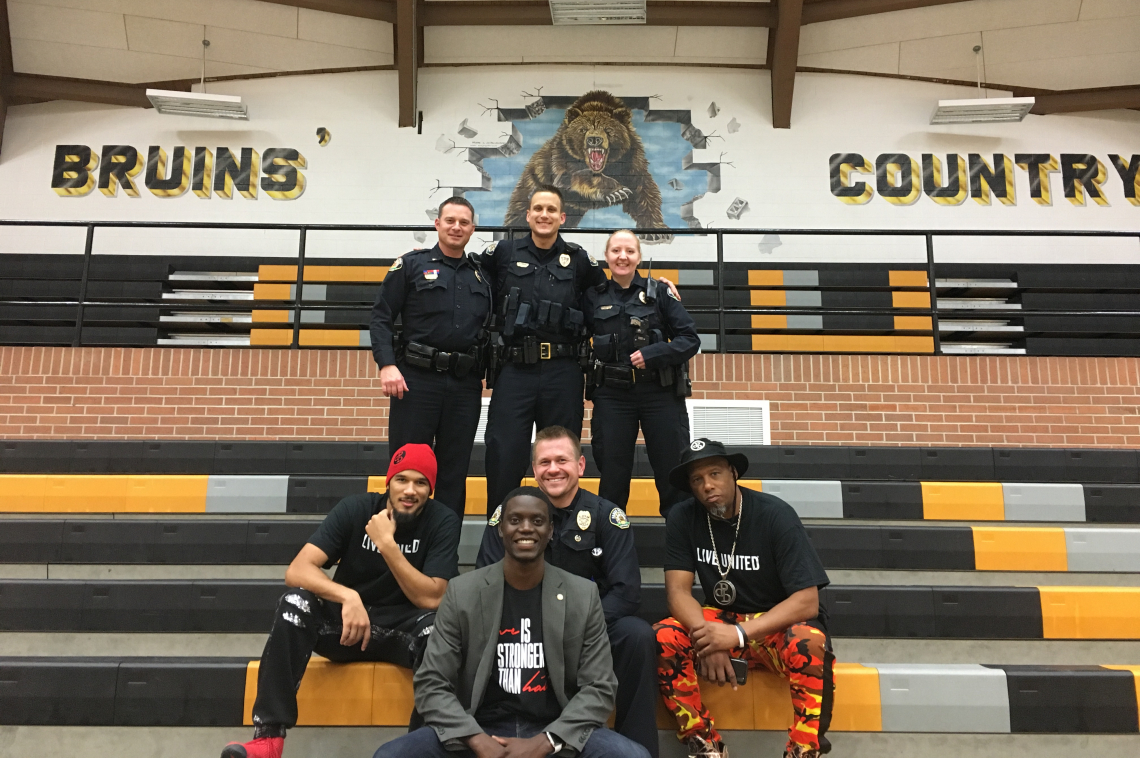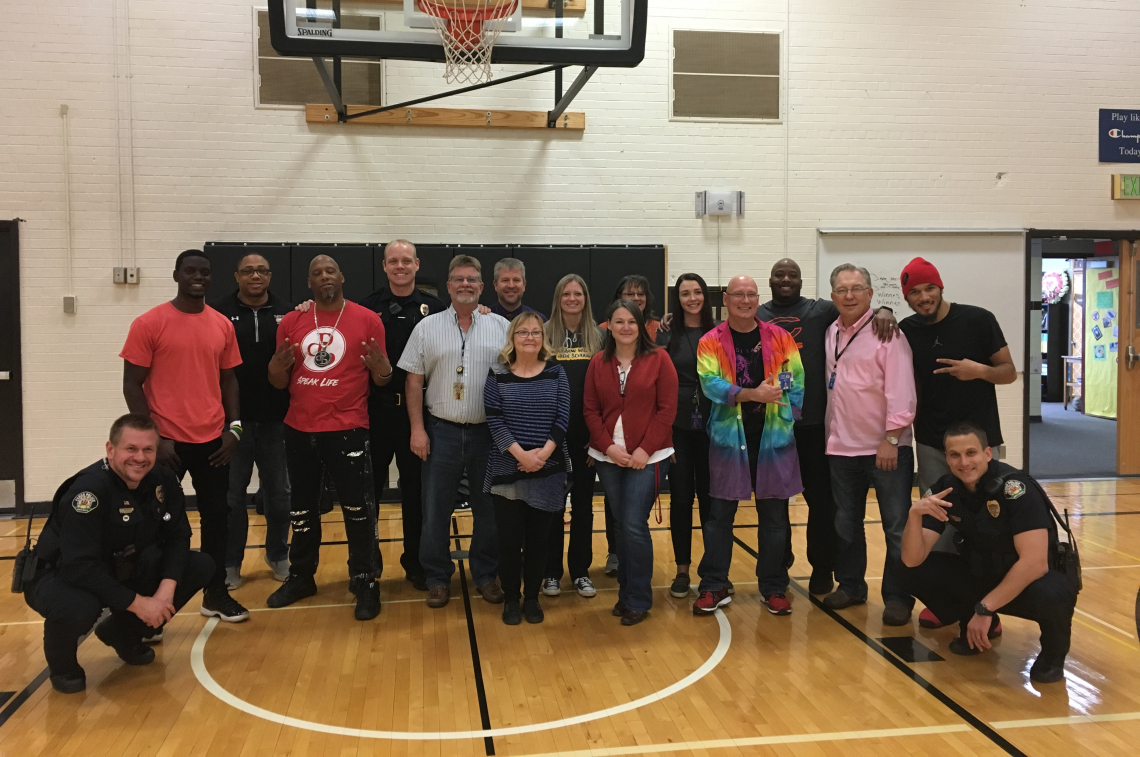

While the concept of community policing isn’t new (its roots stretch back to 19th century London), implementing it in modern day America has been difficult for many communities. Even if local precincts agree on the tenets of the philosophy, they can struggle to find ways of enacting them.
Michael Bloom has some words of wisdom to share. A Fargo, North Dakota-based police officer and rapper, Bloom has partnered with Alabama-based rap artist DPB on two music videos—"Unity” and “It’s Time”—that “star the Fargo community and it represent what unity in action looks like.” The videos have received over 9,000 and over 5,000 views on YouTube, respectively, and dovetail with other Fargo Police Department initiatives, including “It’s Time” school assemblies where students—and teachers—are invited to dance, and a summer camp where kids use music and other creative activities to help them work through their problems.
ArtPlace asked Officer Bloom about his own connection to music, the issues his city is facing, and how creativity is informing community policing in Fargo.
ArtPlace: When did you become a police officer, and why?
Officer Bloom: Law enforcement found me. I became a police officer in February of 2014, just because I loved working with people, especially people who are hurting or who may have deeper issues than most. I had come out of working in jails, with inmates, but I wanted to broaden my horizons and get outside more.
ArtPlace: How long have you been rapping? What draws you to it?
Officer Bloom: I have been rapping since probably high school. I never pursued rap as a job, or tried to make a label, but rap has always been close to my heart. Music is a language that a lot of people speak—whether that’s through the themes in it, or through the different artists… I can’t sing or play instruments, but I can use rap as a bridge-builder to connect with people.
I wasn’t involved with any rap performing before this—except I did meet DPB on a mission trip in South Side, Chicago some years ago. He got me on stage and we rap battled!
ArtPlace: You are one of three “Community Trust Officers” (CTOs) in Fargo. Is that title unique to the Fargo Police Department? What does it mean?
Officer Bloom: I believe it’s unique to us. We got a grant through the Department of Justice and got this CTO position. The grant had a variety of focuses, but a lot of it had to do with reaching low-income youth who might have grown up in a community where law enforcement wasn’t trusted. So we are working to build trust with youth around the region.
ArtPlace: The Fargo Police Department and DPB have so far produced two songs and music videos together. Why did you choose music and video as means of communicating your message?
Officer Bloom: For us, we’re trying to be unique. We wanted to get our message out and to as many people as possible. Our message isn’t just that police are doing good things, but that the community is doing good things. The message is that it’s time for you to be a leader in your city, in your community. It’s, “Look at these people, what they’re doing, the impact they’re having, the different races and nationalities involved.”
ArtPlace: What are the biggest public safety issues in Fargo right now—or historically?
Officer Bloom: You and I have both seen how America is changing lately. Mass shootings, wildfires, the list goes on. For the Fargo community, the problems change. People are hurting all the time. People are suicidal. Relationships are hurting—we’re taking domestic calls every day. How many people old and young are hurting; it’s incredible. How many people are in a hard place; it’s hard to see that.
People lifting people up helps that hurt. Getting others out to serve helps meet those needs. It helps both of those parties get to a new level.
ArtPlace: What do you think “traditional,” or more punitive, policing methods get wrong about public safety, versus the community-oriented approach you’re taking?
Officer Bloom: For the longest time, it was no one’s fault. Policing was, “We’re here to protect”—but protect meant enforce. In hindsight, that can be a good thing, especially in high-crime cities. But when we go out for non-enforcement activities, when we’re just going out to be part of the community, we’ve seen such a positive response that we had to keep doing it.
The news can communicate the story that all minorities don’t trust police. But we’ve had people of all races compliment us on this community engagement style; parents of all nationalities reach out to us to thank us. It just works. People respond so positively to it. Non-enforcement outreach is a great way to connect with your community.
ArtPlace: What creative steps would you recommend other police departments around the country take to increase public safety and overall public health in the communities they serve?
Officer Bloom: I think probably two ways. One is you just gotta start small. So much of what we’ve done is just engaging youth one on one, doing recreational and creative activities. Just spending time with them doing the things they like to do. That time might not feel super productive to you as the adult, but it’s super productive for them.
Two, if you’re afraid to be different, you won’t make much difference. People wonder why we’re doing these different things like rap videos, and it’s because our audience is kids—we can’t talk to them like all the other adults talk to them, or they won’t tune in. You need to stand out to get your message across.
ArtPlace: Can you tell me more about some other creative community policing initiatives you’re excited about?
Officer Bloom: This year, we had “It’s Time” school assemblies. We got so much positive feedback from those. Chris Singleton [whose mother was killed in the 2015 Charleston church shooting] was our guest speaker. He brought this message of “love is always stronger than hate” and how to recover from the unthinkable. I spoke briefly and did a little rapping. DPB was there and got the kids to come up and do all the dances he was doing. Teachers were up and dancing at most schools. The crowd was really engaged. When you’re working with youth, you have to really keep them going or you lose them quick.
And our summer camp is going to happen again next year. Officer Matt Niemeyer has headed it up for the last three years. He works with behavior interventionists in schools; they work with the same kids all year. They do a lot of physical activities at camp as well as creative ones like music lessons. The youth really grow through those activities and learn how to cope with a lot of the emotional issues of growing up.
ArtPlace: Anything else you’d like to tell ArtPlace readers about your work?
Officer Bloom: Anyone can make a difference in their community if they’re willing to work for it. I’ve learned by doing that it is a lot of work, but if you’re willing to connect with people, you can really make anything happen in your community. I would challenge people to step up and engage with their city.
Read more about creativity in community policing on ArtPlace:
- Community Engagement and the Future of Policing





